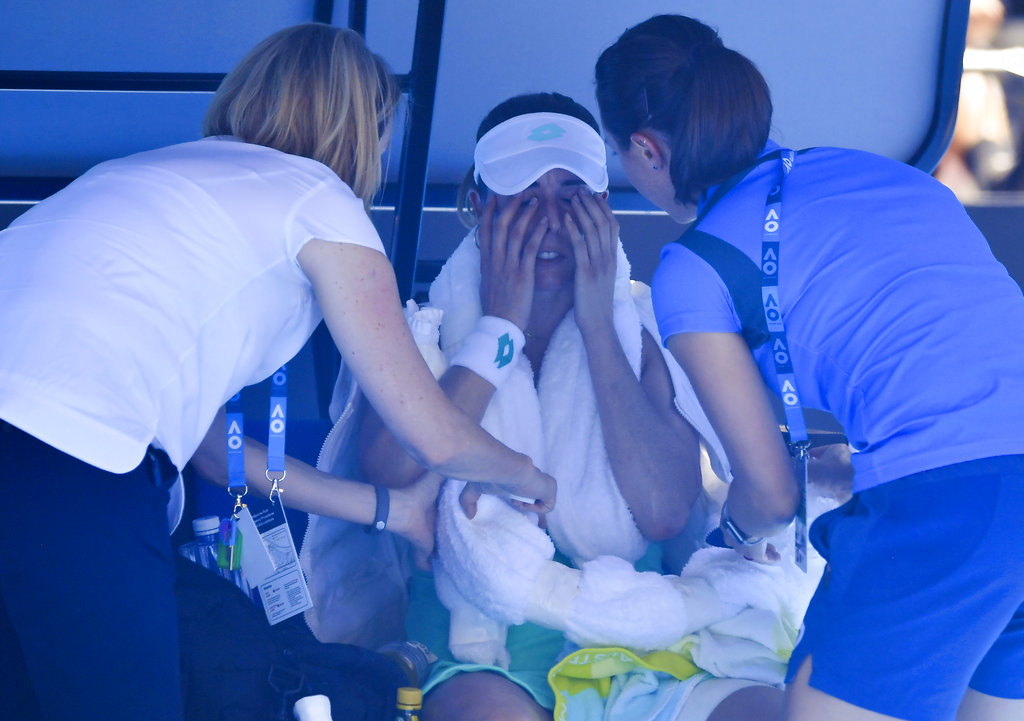
France’s Alize Cornet is attended to by a trainer and tournament staff after suffering from the heat during her third round match against Belgium’s Elise Mertens at the Australian Open tennis championships in Melbourne, Australia, Friday, Jan. 19, 2018. (AP Photo/Andy Brownbill)
MELBOURNE, Australia — French player Alize Cornet has called for the extreme heat policy at the Australian Open to be re-evaluated after she said she nearly fainted in the broiling temperatures during her third-round match Friday at Melbourne Park.
Other players echoed her concerns, with Rafael Nadal saying playing in such extreme heat can be “a little bit dangerous for the health.”
“Have been very, very tough conditions yesterday and today,” said the top-ranked Nadal, who played at night on Friday after the temperatures had dropped. “It’s not nice to see players suffering that much on court.”
The tournament’s extreme heat policy calls for the roofs to be closed on the main show courts and play to be suspended on outer courts when the temperature reaches 40 degrees Celsius (104 Fahrenheit) and the wet-bulb globe temperature (WBGT), which takes into account humidity and wind speed, reaches 32.5 Celsius (90.5 Fahrenheit).
The high temperature Friday marginally topped 40 Celsius, but the WBGT remained below the threshold, so play was not halted.
Cornet said she began feeling dizzy at the beginning of the second set against Belgium’s Elise Mertens and, at one point, fell to her back on the court in obvious distress. She received a medical timeout so a trainer could check her pulse and blood pressure and wrap her in an ice vest before she returned to the court.
Cornet was able to finish the match, losing 7-5, 6-4. But she later said it was “dangerous” to play in that kind of heat.
“The (official) limit of not playing the match is really high. I think this limit should be a little bit lower because playing in this condition is not nice for anyone,” she said. “I would never give up because of (the heat), that’s for sure. But you push your body so hard, you almost feel like you’re on the edge.”
Tournament director Craig Tiley defended the response of officials to the extreme heat on both Thursday and Friday, saying “we start the event with this set of rules and policies in place, and in the interest of fairness, can’t change them halfway through.”
“Protecting our players and the fairness of the competition is paramount in these conditions, which we acknowledge can be challenging,” he said, adding the extreme heat policy would be reviewed after the tournament to see if adjustments need to be made.
Petra Martic, who won a two-hour, third-round match against Luksika Kumkhum during the hottest part of the day on Friday, said she got blisters on her feet from the sizzling court and had to take painkillers after the second set.
“It’s really tough on your feet to play in these conditions,” she said. “I was hoping they would close (the roof), but the temperature was not high enough. … So unfortunately it stayed this way.”
French player Gael Monfils staggered through part of his second-round loss to Novak Djokovic on Thursday, saying he “had a small heat stroke for 40 minutes,” and likewise described the conditions as a risk to players.
Roger Federer, who requested to play at night to avoid the blistering heat on Thursday, said he believed the officials were doing the best they could under the circumstances.
“What do you do … stop all matches? The lucky guys on the big courts, they get to play under the roof. The other guys get postponed till the next day? Is that great?” he said. “Is everybody going to finish at 3 in the morning, like a rainy day in New York. I’ve had that, too. Is that better? I’m not sure, honestly.”

